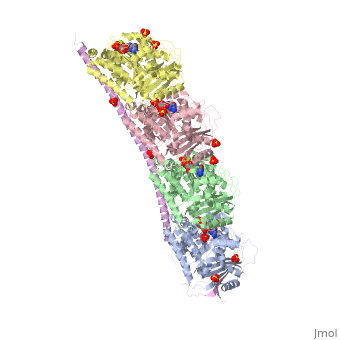Stathmin
FunctionStathmin (STM) regulates microtubules dynamics. Microtubules undergo continuous assembly and disassembly in the cell’s cytoskeleton. STM binds to tubulin and prevents the latter from polymerization thus preventing microtubule assembly. Phosphorylation of STM weakens the binding of STM to tubulin enabling the microtubule assembly needed for the formation of mitotic spindle. Thus, STM is an oncoprotein. STM contains an SLD (Stathmin-Like Domain) domain of 149 residues which binds the tubulin dimer[1]. DiseaseDecreased levels of STM are found in brains of adults with Down syndrome and Alzheimer disease[2]. RelevanceStructural highlights |
| ||||||||||
3D Structures of stathmin3D Structures of stathmin
Updated on 01-September-2016
ReferencesReferences
- ↑ Curmi PA, Gavet O, Charbaut E, Ozon S, Lachkar-Colmerauer S, Manceau V, Siavoshian S, Maucuer A, Sobel A. Stathmin and its phosphoprotein family: general properties, biochemical and functional interaction with tubulin. Cell Struct Funct. 1999 Oct;24(5):345-57. PMID:15216892
- ↑ Cheon MS, Fountoulakis M, Cairns NJ, Dierssen M, Herkner K, Lubec G. Decreased protein levels of stathmin in adult brains with Down syndrome and Alzheimer's disease. J Neural Transm Suppl. 2001;(61):281-8. PMID:11771751
